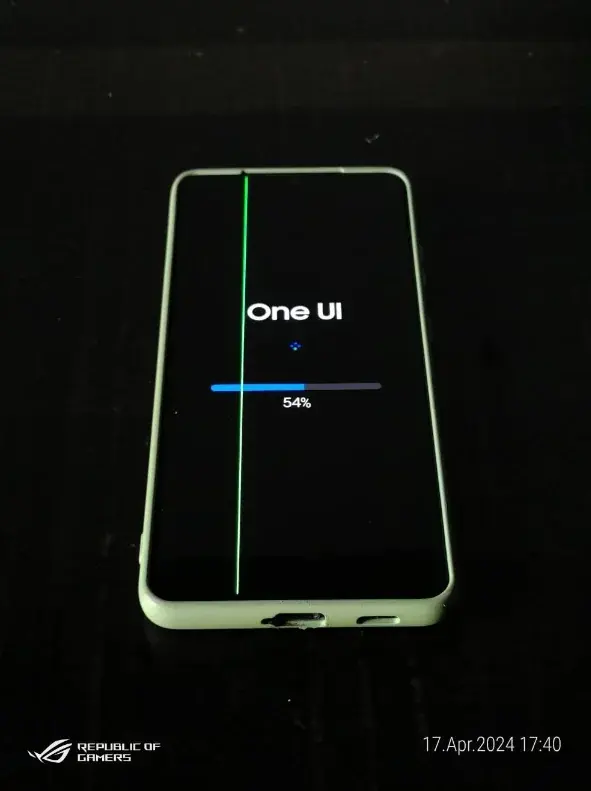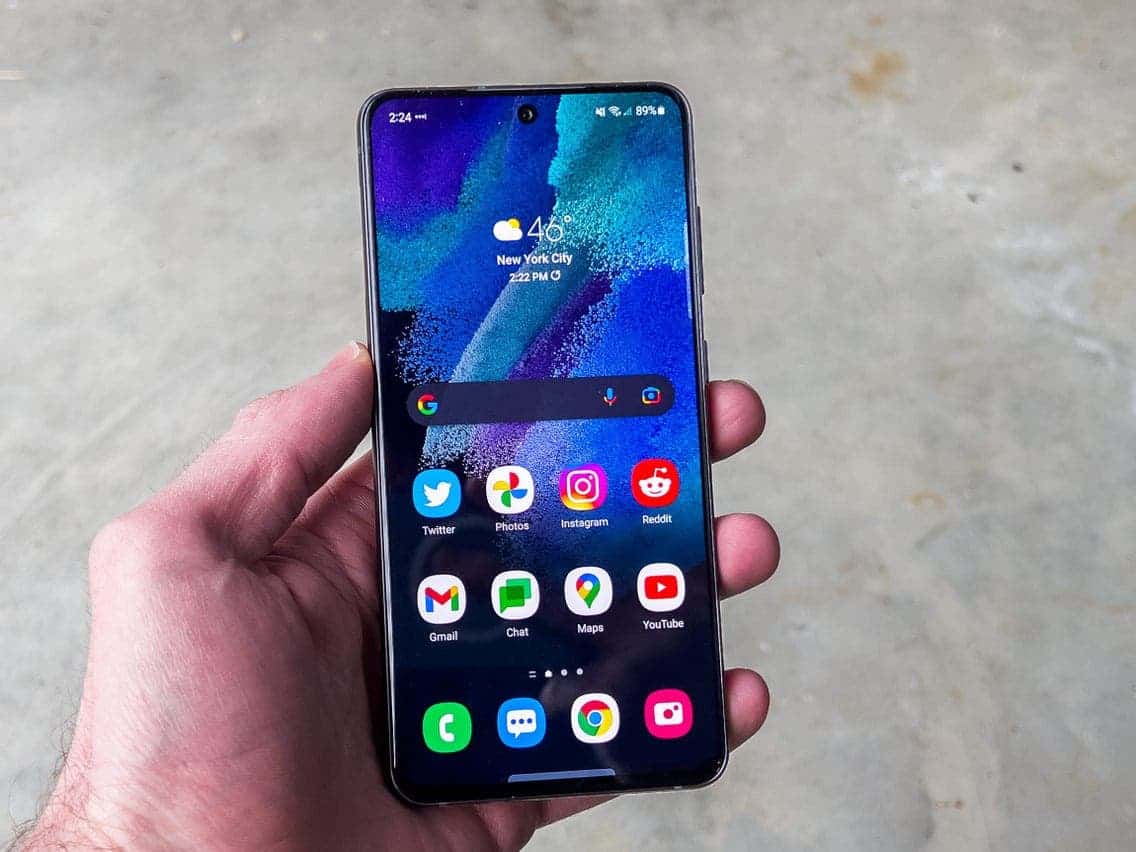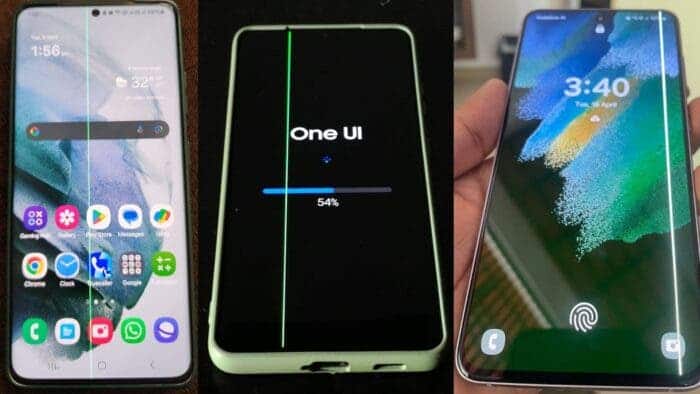The persistent issue of green lines appearing on smartphone screens continues to plague the industry, and Samsung’s Galaxy line of phones seems to be the latest victim. Since last week, reports on social media, particularly in India, have surged regarding a green line obstructing the displays of various Galaxy models.
Persistent Green Lines Plague Samsung Galaxy Phones: A Hardware Issue or Software Glitch?

While some users attribute the issue to a recent software update, Samsung’s proposed solution leans towards a hardware malfunction. The company has announced a free screen replacement program for affected users in India.
Recurring OLED Display Issues
The problem of green lines on OLED screens isn’t new. Over the past few years, brands like OnePlus have faced similar issues. With Samsung encountering a wave of cases in 2023. This recent recurrence affects the Galaxy S20, S21, S22, and Note 20 series, leaving users with an unwelcome green line marring their displays. The presence of multiple lines further exacerbates the problem.
Green lines typically signify a hardware failure, often requiring a costly screen replacement if not covered by warranty. Several affected users claim the issue surfaced after a recent firmware update, but a cause-and-effect relationship remains unconfirmed.
User Concerns and Preventive Measures
The widespread concern has prompted some users to resort to recording videos of their phones during system updates. This serves as a form of documented evidence that the phone functioned properly before the update, potentially aiding future troubleshooting efforts if a green line appears subsequently.
The prevalence of the issue has spurred Samsung to address it, at least in the Indian market. The company has implemented a free screen replacement program for the aforementioned Galaxy models, provided the phones were purchased within the last three years, regardless of warranty status. As an added gesture of goodwill, Samsung will also replace the battery for affected devices if the screen replacement is requested before April 30th, 2024.
While this is positive news for Galaxy S and Note users facing the green line issue, it doesn’t extend to owners of other models like the Galaxy M, A, and S FE series.
Possible Causes and Solutions
While the definitive cause of the green lines remains unclear, several potential factors can be considered:
- Loose Display Connection: A loose connection between the display panel and the motherboard can disrupt signal transmission, leading to visual artifacts like green lines.
- Faulty Display Panel: Manufacturing defects or physical damage to the display panel itself can also cause malfunction and display issues.
- Software Conflicts (Unlikely): Though user reports suggest a correlation with recent software updates, it’s less likely to be the root cause. Software updates typically don’t directly damage hardware components. However, in rare cases, software glitches could exacerbate existing hardware issues that might go unnoticed initially.
Recommendations for Affected Users:
If you’re a Galaxy S or Note user in India experiencing green lines on your phone’s display, here’s what you can do:
- Contact Samsung Support: Reach out to Samsung customer service to inquire about the free screen replacement program and determine if your device qualifies.
- Gather Proof of Purchase: Have your phone’s purchase receipt readily available to verify eligibility for the program.
- Back Up Your Data. Before sending your phone in for repair, ensure you have a recent and complete backup of your phone’s data to prevent loss.
- Explore Additional Options: If you’re not located in India or your device doesn’t qualify for the free screen replacement program, consider contacting a reputable third-party repair service specializing in mobile phone displays. However, always ensure the repair service uses genuine replacement parts.
Future Considerations
The recurrence of green lines on Samsung Galaxy phones highlights the importance of robust quality control measures throughout the manufacturing process. Additionally, thorough software testing should be conducted to ensure compatibility with existing hardware components and prevent potential software-induced hardware issues.
For affected users, Samsung’s free screen replacement program in India offers a welcome solution. However, addressing the root cause of the issue remains paramount. Further investigation into the cause of these green lines is crucial to prevent future occurrences and ensure user confidence in Samsung’s Galaxy lineup.
Beyond the Green Lines: A Look at Broader Smartphone Display Issues

The issue of green lines plaguing Samsung’s Galaxy phones is just one example of a wider range of problems that can affect smartphone displays. Let’s delve deeper into some of these common display malfunctions and explore potential preventative measures.
Common Smartphone Display Issues:
- Dead Pixels: Tiny, permanently lit or unlit spots on the display can appear due to manufacturing defects or physical damage.
- Screen Burn-in: Faint outlines of images that are persistently displayed on the screen, often caused by prolonged static content display.
- Touch Screen Unresponsiveness: Inability of the touchscreen to register touch inputs due to hardware malfunctions or software glitches.
- Flickering or Distorted Display: Unstable or distorted visuals on the screen, potentially caused by loose display connections or hardware issues.
Preventative Measures for Display Problems:
- Use a Screen Protector. A high-quality screen protector can help shield the display from scratches and impacts that could lead to physical damage.
- Adjust Brightness Settings. Maintaining a moderate screen brightness level can help reduce stress on the display components and potentially minimize the risk of burn-in.
- Enable Auto-Lock. Setting your phone to automatically lock after a period of inactivity prevents static images from being displayed for extended periods. Reducing the risk of screen burn-in.
- Avoid Extreme Temperatures. Exposing your phone to very high or low temperatures can stress the display components and potentially lead to malfunctions.
- Update Software Regularly. Keeping your phone’s software up-to-date ensures you benefit from bug fixes and performance optimizations that may address display-related issues.
- Handle Your Phone with Care: Accidental drops and bumps are a leading cause of display damage. Treat your phone with care and avoid placing unnecessary strain on the display.
The Importance of User Advocacy:
When encountering display issues, users play a crucial role in advocating for themselves and bringing such problems to light. Reporting issues to the manufacturer allows them to track the prevalence of specific problems and take corrective actions.
Social media platforms can also be a powerful tool for users to share their experiences and raise awareness about recurring display issues with specific phone models. This collective voice can put pressure on manufacturers to prioritize quality control and address widespread problems effectively.
The Future of Smartphone Displays:
As smartphone technology continues to evolve, display technology is also undergoing significant advancements. We can expect to see features like:
- More Durable Displays: Improved materials and manufacturing processes will lead to displays that are more resistant to scratches, cracks, and other forms of physical damage.
- Flexible Displays: Foldable and rollable displays will offer innovative form factors and user experiences.
- Higher Refresh Rates: Displays with smoother refresh rates will provide a more responsive and visually pleasing user experience.
- Advanced Display Technologies: Emerging technologies like under-display cameras and improved fingerprint sensors integrated into the display will offer enhanced functionality and a sleeker design aesthetic.
Conclusion:
The green line issue on Samsung Galaxy phones serves as a reminder of the importance of display quality and reliability in smartphones. By implementing stricter quality control measures, conducting thorough software testing, and continuously innovating display technology, manufacturers can ensure a positive user experience.
For users, staying informed about common display issues, taking preventative measures, and advocating for themselves when problems arise all play a part in maintaining the optimal performance of their smartphone displays. As display technology continues to advance, we can expect even more immersive and reliable visual experiences on our smartphones in the years to come.





